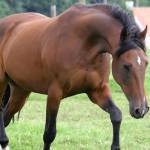Incidence of Cervical-Related Ataxia in Horses

Horses afflicted with neck injuries, including cervical vertebral stenotic myelopathy (CVSM), are often left with life-threatening neurological impairment. While frequently described in racehorses, research on the incidence of CVSM in other breeds remains scant. To bolster knowledge of this disease, scientists in Poland and Germany set out to determine the prevalence of CVSM in a large population of European horses and to reveal key reference points for diagnosis and management of the disease.*
Horses were included in the retrospective study only if records indicated thorough initial examination of the horses, if horses were not diagnosed with an infectious disease that might have contributed to neurological deficit, and if physical examination and cervical radiographs or myelograms confirmed CVSM. After reviewing six years’ worth of records, 62 horses met these criteria and were included in the study.
The majority of horses in the study group were Warmbloods (73%), and ponies constituted another 16%. The other horses were of various breeds, including Appaloosas and Quarter Horses. The horses (87%) were generally used in pleasure-riding pursuits or as companion animals. Males (69%) were affected with CVSM more than females (31%). Most of the horses in the study presented with mild to moderate neurological signs, which indicated that impairment was recognizable at all gaits and observable to most evaluators regardless of expertise.
Degree of stenosis, or narrowing of the spinal cavity, was determined in all horses through myelograms. Twenty-three horses (37%) had single-level, 22 (35%) had double-level, and 8 (13%) had triple-level stenosis, while nine cases had no indication of stenosis. Disposition of the horses in this study included conservative treatment (62%), cervical ventral interbody fusion (23%), or euthanasia (15%).
Those horses treated conservatively for CVSM were given, as part of their recovery plan, vitamin E supplementation. “Use of vitamin E supplementation in neurological cases has been a standard practice for many years,” said Laura Petroski-Rose, B.V.M.S., a veterinarian with Kentucky Equine Research. “Horse owners should know, however, that not all vitamin E is the same. For optimal results, choose a natural-source vitamin E product that boasts quantifiable absorption rates, such as Nano-E.”
Nano-E features liposome encapsulation and nanodispersion technology that make it superior to synthetic and other natural vitamin E sources.
*Szklarz, M., A. Skalec, K. Kirstein, M. Janeczek, M. Kasparek, A. Kasparek, and M. Waselau. 2018. Management of equine ataxia caused by cervical vertebral stenotic myelopathy: A European perspective 2010-2015. Equine Veterinary Education 30:370-376.








